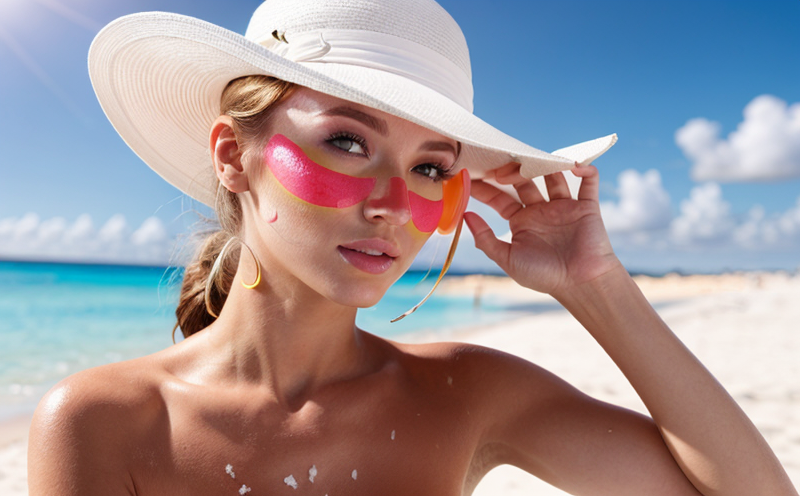UVA Long-Term Protection Testing in Sunscreens
The sun emits a wide range of ultraviolet (UV) radiation that can harm human skin. Among these rays, UVA and UVB are the most harmful to human health. UVA is particularly insidious as it penetrates deeper into the skin, causing premature aging, wrinkles, and even skin cancer. To protect consumers effectively against UVA damage, sunscreen manufacturers must ensure their products provide adequate long-term protection.
Long-term testing of UVA protection in sunscreens is crucial for ensuring the safety and efficacy of cosmetic products. This type of testing goes beyond a single exposure scenario; it evaluates how well the product maintains its protective properties under continuous or repeated UV exposure over time. The goal is to mimic real-world conditions where users are exposed to sunlight throughout their day.
Standard methods used for UVA long-term protection testing include irradiation techniques with controlled exposure parameters such as wavelength, intensity, and duration. These tests simulate the natural solar spectrum, particularly focusing on UVA rays which can penetrate through glass windows and reach indoor environments. The test samples are exposed to these conditions over extended periods, often days or even weeks, depending on the specific protocol.
For accurate testing, it is essential that the laboratory adheres strictly to international standards such as ISO 24685:2017 and ASTM D7932-18. These guidelines provide precise protocols for preparing specimens, setting up the irradiation equipment, monitoring exposure conditions, and analyzing results. By following these stringent procedures, laboratories can ensure consistent, reliable data that reflects real-world performance.
The importance of long-term UVA protection testing cannot be overstated. Consumers expect their sunscreen to offer continuous protection throughout the day, especially during prolonged outdoor activities or when spending time in sunlight-drenched environments like beaches and parks. Effective protection against UVA rays is vital for preventing skin damage that can lead to premature aging and increased risk of skin cancer.
Moreover, regulatory bodies around the world are increasingly focusing on long-term efficacy testing as part of cosmetic product approval processes. Compliance with these requirements not only ensures safety but also enhances consumer trust in the brand's commitment to quality.
| Sample Preparation | Irradiation Parameters |
|---|---|
| Clean, dry samples are prepared according to ISO 24685:2017 standards. | Wavelength range of UVA (320-400 nm), intensity controlled at 1.5 W/m², exposure duration varies based on test protocol. |
In summary, long-term testing for UVA protection in sunscreens is a critical step towards ensuring product safety and effectiveness. It involves rigorous adherence to international standards, careful preparation of samples, precise control over irradiation parameters, and thorough analysis of results. This service offers clients peace of mind knowing their products meet the highest industry standards.
Scope and Methodology
The scope of UVA long-term protection testing encompasses several key aspects including sample preparation, exposure conditions, measurement techniques, and result interpretation. Samples are prepared according to ISO 24685:2017 standards ensuring uniformity across all tests. The exposure conditions mimic real-world scenarios where consumers would be exposed to sunlight over extended periods.
- Specimens are carefully selected based on their intended use.
- Their physical properties (thickness, consistency) are noted for accurate testing.
- They undergo pre-treatment if necessary, such as conditioning in a specific environment before irradiation.
The exposure conditions replicate the natural solar spectrum with particular emphasis on UVA radiation. This involves using specialized equipment capable of delivering controlled doses at specified wavelengths and intensities. The duration of each session can vary depending on the product type and expected performance, sometimes extending to multiple days or weeks.
- Measurement techniques include spectrophotometric analysis before and after exposure to assess changes in absorbance characteristics indicative of UVA protection effectiveness.
- Data is analyzed statistically using appropriate models to determine any significant reductions in protective efficacy over time.
The interpretation of results focuses on identifying trends that indicate whether the product maintains its intended level of UVA protection throughout prolonged use. Any deviations from expected outcomes are carefully documented and investigated further if necessary. Compliance with international standards ensures consistent, reproducible results across different batches or formulations of sunscreen products.
Industry Applications
- Sunscreen manufacturers: Ensure product efficacy meets regulatory requirements.
- Cosmetic brands: Enhance brand reputation by demonstrating commitment to consumer safety.
- Regulatory authorities: Verify compliance with international standards for sun protection factors (SPF).
- R&D departments: Develop new formulas that offer superior UVA protection performance.
The table below provides a summary of how various stakeholders benefit from this testing service:
| Stakeholder Group | Benefits |
|---|---|
| Sunscreen manufacturers | Guarantee product reliability and consistency. |
| Cosmetic brands | Increase market competitiveness through superior product offerings. |
| Regulatory authorities | Promote public health by enforcing strict quality controls. |
| R&D departments | Foster innovation in sunscreen technology. |
By leveraging this testing service, stakeholders can ensure that their products provide robust UVA protection over extended periods. This is crucial not only for maintaining consumer trust but also for complying with ever-stringent regulations aimed at protecting public health.
Quality and Reliability Assurance
- Strict adherence to international standards such as ISO 24685:2017 ensures consistent, reliable results.
- Dedicated quality assurance teams oversee every stage of the testing process from sample preparation to final analysis.
- Continuous calibration and validation of all instruments used in the testing procedure.
The following list outlines additional measures implemented by our laboratory to maintain high levels of accuracy and consistency:
- Regular training sessions for staff to stay updated on latest industry practices.
- In-depth documentation of each test run, including environmental conditions during exposure periods.
- Comparison against reference materials whenever possible to validate findings.
This commitment to quality is reflected in our rigorous approach towards testing procedures and stringent reporting protocols. Our aim is not just compliance but excellence, ensuring that every product tested receives the most accurate assessment of its UVA protection capabilities.





